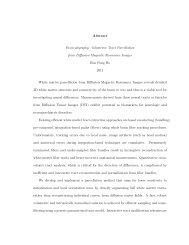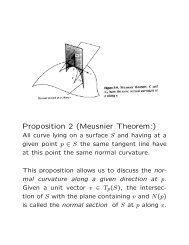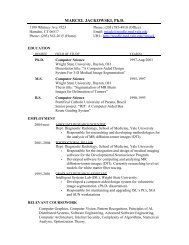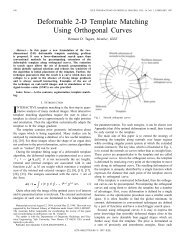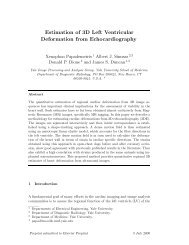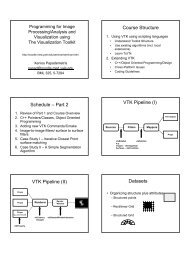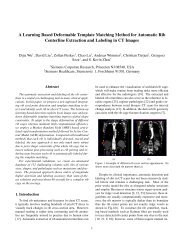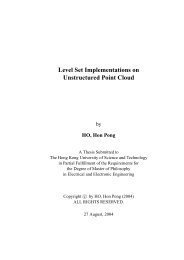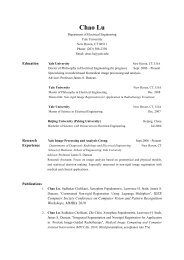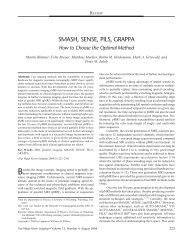Microstructural and Physiological Features of Tissues Elucidated by ...
Microstructural and Physiological Features of Tissues Elucidated by ...
Microstructural and Physiological Features of Tissues Elucidated by ...
You also want an ePaper? Increase the reach of your titles
YUMPU automatically turns print PDFs into web optimized ePapers that Google loves.
214 BASSER AND PIERPAOLI<br />
where Dx, Dy, <strong>and</strong> Dz represent the individual voxel di- tion coefficient. The term containing the delta function, [1<br />
mensions. These definitions apply for both isotropic <strong>and</strong> 0 d(r 0 r)], eliminates the contribution produced <strong>by</strong> the<br />
anisotropic voxels. To mitigate errors introduced at the inner product <strong>of</strong> the reference deviatoric with itself,<br />
boundaries <strong>of</strong> the imaging volume, we can pad the multislice DW (r):DW (r). Since O(r) is a weighed sum <strong>of</strong> scalar invari-<br />
or 3-D images with zeros. The correlation length s in Eq. ants, it too is a scalar invariant. It can also be displayed as<br />
[18] should now be at least as large as the smallest voxel an image whose intensity should be large where the fiberdimension.<br />
tract direction field is regular or relatively uniform. For example,<br />
in normal brain, we would expect a gray-scale image<br />
Fiber-Tract Organization Measures <strong>of</strong> O(r) to be bright in organized regions (such as the corpus<br />
To measure the degree <strong>of</strong> fiber-tract organization, we use<br />
a measure <strong>of</strong> the similarity between the anisotropic parts (or<br />
deviatorics) <strong>of</strong> diffusion tensors in different voxels, DW :DW .<br />
In Appendix C we derive the generalized tensor product<br />
between the diffusion deviation tensors in a reference <strong>and</strong><br />
callosum <strong>and</strong> the optical tract), <strong>and</strong> dark in less-organized<br />
regions (such as fluid-filled ventricles, in gray matter, <strong>and</strong><br />
even some more-disordered regions <strong>of</strong> white matter).<br />
For MR images, we replace the integral with a sum over<br />
discrete voxels in the image space<br />
an arbitrarily chosen voxel, DW :DW , in terms <strong>of</strong> their eigenvectors<br />
<strong>and</strong> eigenvalues, obtaining<br />
3 3<br />
O(r) Å ∑ ∑ ∑ ∑ ∑ lk(r)l s(r)[1<br />
l m n kÅ1 sÅ1<br />
T k (r)1s(r)] 2<br />
3 3<br />
DW :DW Å ∑ ∑ lkls(1 kÅ1 sÅ1<br />
T k 1s) 2 0 1<br />
3 3<br />
3(∑ lk)(∑ ls). [20]<br />
kÅ1 sÅ1<br />
0 1<br />
3 ∑<br />
3<br />
3<br />
lk(r) ∑ ls(r) kÅ1 sÅ1<br />
Equivalently, Eq. [20] can be written as<br />
DW :DW Å DW :DW 0 3»D…»D…, [21]<br />
1 <br />
1 <br />
(2p) 3 s 2 exp 0(r 0 r)T (r 0 r)<br />
2s 2<br />
where we have used Eq. [5] above. Therefore, the tensor<br />
product between two diffusion deviation tensors is the tensor<br />
1 (1 0 d(r 0 r))DxDyDz [23]<br />
product between their respective diffusion tensors minus<br />
three times the product <strong>of</strong> their respective mean diffusivities.<br />
Since DW :DW <strong>and</strong> »D… »D…are both invariant, DW :DW is also<br />
<strong>and</strong> use the substitutions in Eq. [19b] above.<br />
invariant.<br />
Now that we have defined an invariant measure <strong>of</strong> similar-<br />
MATERIALS AND METHODS<br />
ity for anisotropic structures, we can again apply the convo- MR data were obtained with a General Electric 2.0 T<br />
lution averaging procedure used above to develop a measure Omega MR system (GE NMR Instruments, Fremont, Cali-<br />
<strong>of</strong> fiber organization. To retain information about local order fornia) equipped with self-shielded gradients (Acustar 290)<br />
(i.e., tissue domains with similar structure <strong>and</strong> orientation) capable <strong>of</strong> producing pulses up to 4.0 G/cm. A homebuilt<br />
within the vicinity <strong>of</strong> the reference voxel, we again weight quadrature coil (13 cm diameter) was used as a radi<strong>of</strong>re-<br />
the scalar matrix products between deviatorics in neigh- quency transmitter <strong>and</strong> receiver. We acquired 21 axial<br />
boring voxels more heavily than we do those between distant multislice diffusion-weighted 2D spin-echo images <strong>of</strong> living<br />
ones. By analogy, we define a correlation measure <strong>of</strong> organi- cat brain in under 3 h. Imaging acquisition parameters were<br />
zation, O(r):<br />
as follows: four axial slices, 2 mm slice thickness, TR/TE<br />
<strong>of</strong> 2000/70, two repetitions per image, 90 mm field <strong>of</strong> view,<br />
O(r)<br />
40 kHz b<strong>and</strong>width, 128 1 256 in-plane resolution. Different<br />
Å 1<br />
V V<br />
DW (r)<br />
<br />
DW (r):DW (r) :<br />
<br />
DW (r)<br />
levels <strong>of</strong> diffusion weighting were obtained <strong>by</strong> varying the<br />
strength <strong>of</strong> pairs <strong>of</strong> trapezoidal gradient pulses placed on<br />
DW (r):DW (r) both sides <strong>of</strong> the 180 pulse between 0 <strong>and</strong> 3 G/cm (17–<br />
19). The diffusion sensitizing gradients had a duration <strong>of</strong><br />
1 K(r 0 r)[1 0 d(r 0 r)]dr 3 . [22] 19 ms <strong>and</strong> were separated <strong>by</strong> a time interval <strong>of</strong> 20 ms. The<br />
highest b-matrix values were on the order <strong>of</strong> 850 s/mm 2 The normalization <strong>of</strong> the deviatorics in the integr<strong>and</strong> guaran-<br />
.<br />
Diffusion gradients were applied in seven noncollinear directees<br />
that the anisotropic macrostructural similarity index will tions (20). From the measured T2-weighted signal, A(TE),<br />
always lie between 0 <strong>and</strong> 1, with 0 indicating no order <strong>and</strong> <strong>and</strong> the b matrix calculated from each sequence (21), we<br />
1 indicating a locally uniform fiber-tract pattern. The tensor estimated DW in each voxel, using weighted multivariate linear<br />
product in the integr<strong>and</strong> <strong>of</strong> Eq. [22] now resembles a correla-<br />
regression <strong>of</strong> (20):



